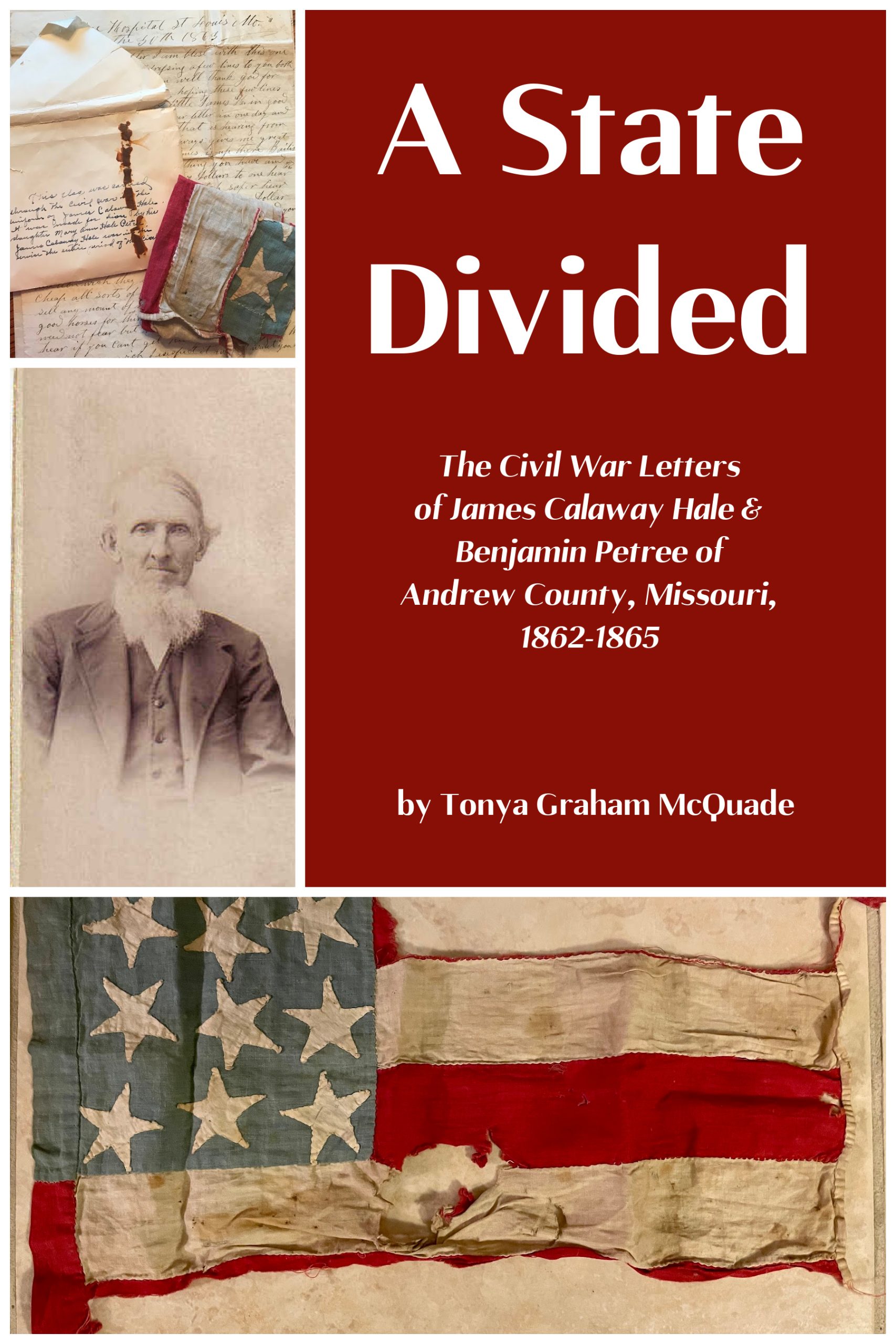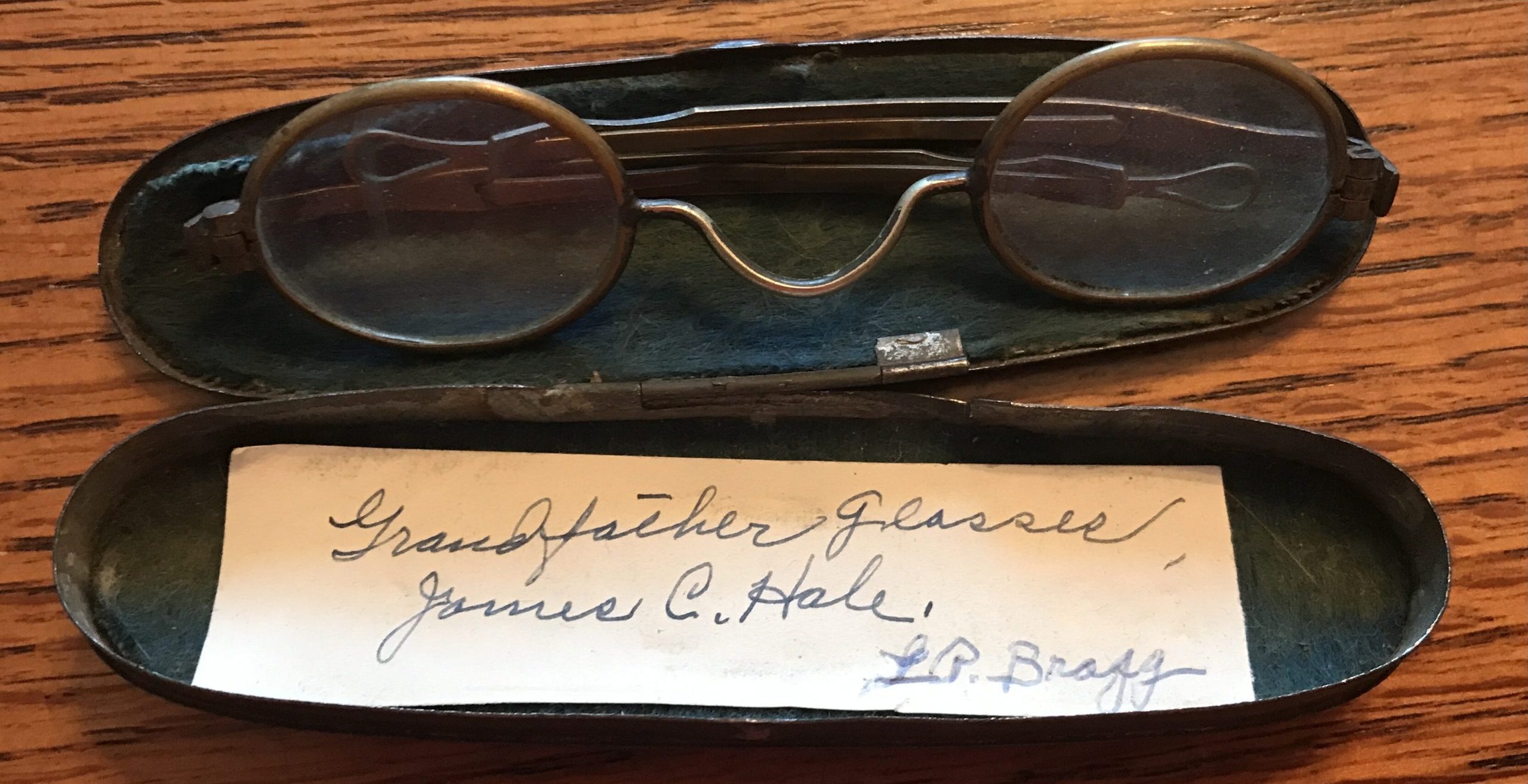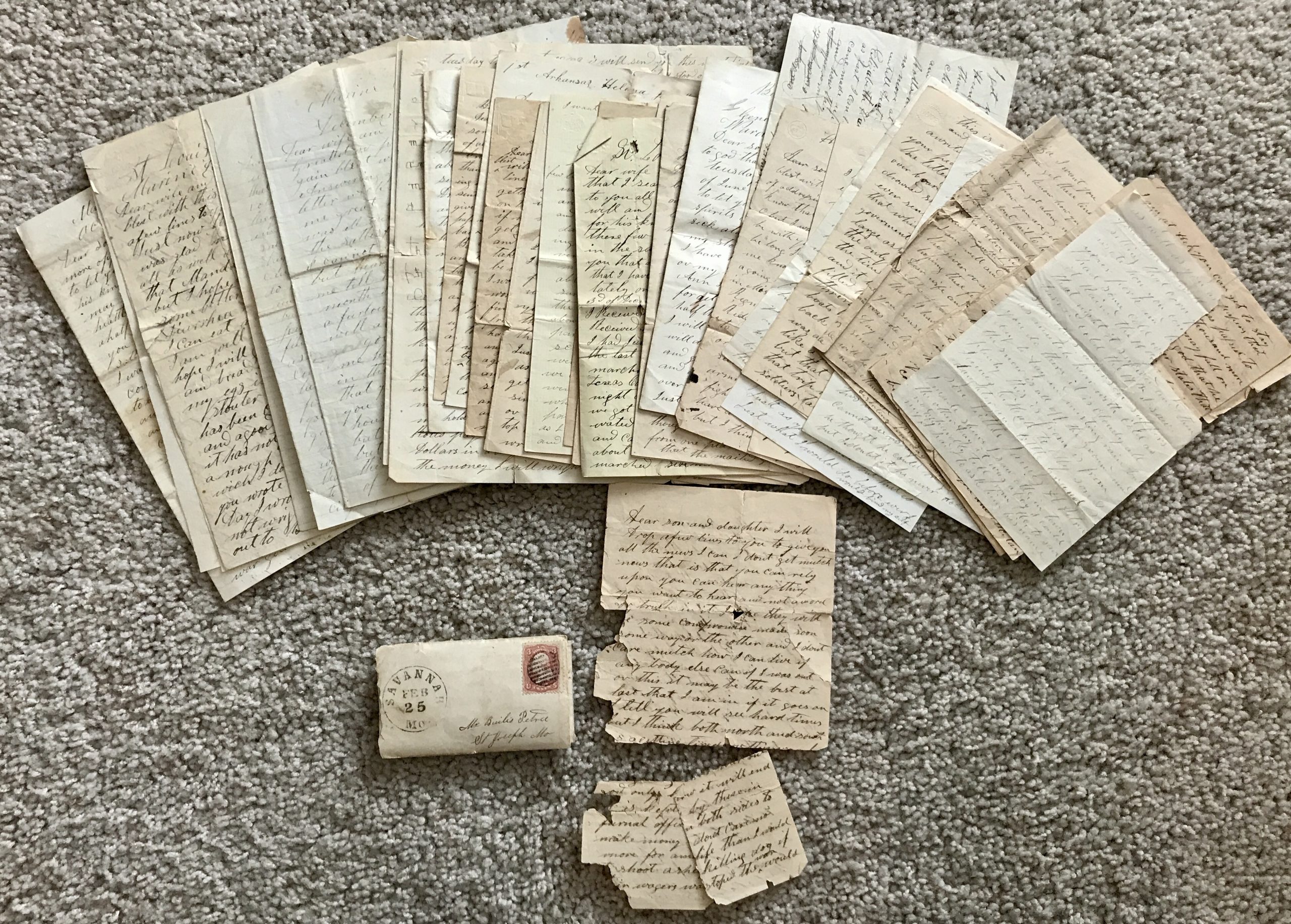A State Divided: A New Book Featuring 50 Previously-Unpublished Civil War Letters Provides Insights on Why Many Believe the Civil War Started in Missouri

On February 1, 2022, I received an email that changed the trajectory of my life in significant ways. Someone named Jeremy reached out to me on Ancestry.com saying he had a box of old letters and other items belonging to my ancestors. Many of the letters were addressed to my great great grandparents, Bailis Petree and Mary Ann Hale Petree (he had found their names in my family tree on the website), and he asked if I wanted the letters. As he wrote:
I have no relation to the Petrees but I do have an interesting story. Back in the early 90’s my father stumbled upon a bunch of letters and pictures of the family going back to James C. Hale, father of Mary Hale who was married to Bailis Petree. It’s quite a collection of your family history. I got to thinking if someone had my family history, I’d want to know. If you are at all interested, send me your cell number, and I can send you pictures or you can text my cell.
As soon as I read Jeremy’s message, I immediately texted back. The following night, we had an hour-long conversation on the phone, then arranged for him to send me the box of old letters, photos, and memorabilia.
Thus began my new adventure: tracing my 3rd great grandfather James Callaway Hale’s steps through the Civil War in Missouri, Kentucky, and Arkansas, and researching key people, events, and impacts of the Civil War in Missouri. Along with James’s letters, I also discovered Civil War letters from Bailis’s brother, Benjamin Petree, as well as other family letters – including several written by friends and family members who had taken the Oregon Trail to California, Oregon, and Washington in the 1850’s-60’s. The box also included a pair of James C. Hale’s eyeglasses; a flag his daughter Mary Ann made for him, which he carried with him throughout the Civil War; several tintype photos of family members; and pieces of material from dresses worn by various women in the family.

Initially, my goal was to read through the letters and transcribe parts that were important to understanding my family history, but I soon realized that what I had in my hands would be interesting to people outside of my family as well. Reading through the letters gave me detailed insights into many aspects of history and provided a multitude of unique perspectives, and I soon felt compelled to share. There was even one written to Bailis by two cousins supporting the Confederate side, who signed their names “Rachel at Rebel Rendezvous” and “Nancy Neutrality.” In my letter transcriptions, I tried to keep the original word choice as much as possible in order to maintain each author’s voice, but in many cases I corrected spelling errors and added punctuation to make reading easier.
As I quickly learned in my research and from reading these letters, Missouri was a state torn apart by the Civil War. Many, in fact, believe the Civil War started here. Long before the firing on Fort Sumter, the Missouri Compromise, the Kansas-Nebraska Act, the Dred Scott case, the Fugitive Slave Law, and the “Bleeding Kansas” border wars were sparking division, disagreement, and at times violence in Missouri. Some of the first blood shed during the war was spilled on Missouri soil during the Camp Jackson Affair. The first Union general to be killed – Brig. Gen. Nathaniel Lyon – died in combat near Springfield at the Battle of Wilson’s Creek. Soon, the state even found itself with two competing governments, one recognized by the Federal government and one by the Confederacy.
Like so many in Missouri, the Hale and Petree families found themselves caught in this political maelstrom. Originally from Tennessee and Indiana, each had relatives who fought and died on both sides of the war. James C. Hale volunteered early on to join the Union army, spending time in Missouri, Kentucky, and Arkansas, where he watched the buildup to Vicksburg from Helena. He ended up spending much of his enlisted time at Benton Barracks in St. Louis, first at the General Hospital for medical treatment then later in the Veteran Reserve Corps at the Marine Hospital. Benjamin Petree was drafted toward the end of the war and found himself participating in Gen. William Tecumseh Sherman’s Carolinas Campaign, where he witnessed huge amounts of action, devastation, and destruction before marching in the majestic Grand Review of the Union Army in Washington, D.C. to celebrate the Union victory.
While they were serving in their respective regiments – James in the 33rd Missouri Infantry and Benjamin in the 18th Missouri Infantry – they wrote letters home to their families to keep them informed as to their health, condition, and whereabouts. Their letters cast light on this pivotal border state that saw 42% of the battles in the U.S. during the first year of the war and suffered more than 1,000 total battles on its soil, making it the third most fought-over state after Virginia and Tennessee. Missouri also experienced one of the last surrenders – that of Confederate Lt. Gen. Edmund Kirby Smith, who commanded the Trans-Mississippi Department west of the Mississippi River – 47 days after Gen. Robert E. Lee’s surrender at Appomattox, Virginia.

In my first article for the Emerging Civil War website, which focused on the September 27, 1864 Centralia Massacre in Centralia, Missouri, I shared an excerpt from one of James’s letters. In it, he discusses a “lucky escape” that resulted from not getting the furlough he had requested. Because he was forced to stay at Benton Barracks in St. Louis, he was not on the train that guerrillas attacked in the Centralia Massacre, where they killed 22 soldiers, scalping and mutilating some of them. As James writes in his letter to his daughter and son-in-law:
O, but I made a lucky escape the other day by not starting home. The very train I would have been on was all massacred – stopped the [railroad] cars. They was twenty-four soldiers on it. They shot them dead, robbed the train, set fire to it, and started it running down the track before it burnt up. About three o’clock they came across some more soldiers and killed and scalped another lot. All amounted to one hundred and twenty-two. I am afraid to start home at this time. I would like to be at home, but I will hold on a few days longer….
In another of his letters from St. Louis, James describes how impressed he is by the Marine Hospital, where he was then serving:
The Marine Hospital is almost the best building in the city large. I don’t know how many rooms they is in it. You can get water from the bottom to the top. Just turn a faucet and here will come the water – cold water and hot water both. It is a plum curiosity to see the ingenuity that is in man. This house has not been built long – government built it. Just look at the expense government has been at since this infernal Rebellion broke out and at the lives lost. You can hear the news of all the Battles in the papers. We hear every day almost – they come every day with papers to sell five cents a paper.
James eventually got his furlough and spent the first Christmas in three years with his family in December 1864 before returning to St. Louis. In November of that same year, Benjamin Petree was drafted. He had to leave behind his wife and three children, ages three, two, and seven months, to join up with Gen. William Tecumseh Sherman’s troops in South Carolina. In one of his letters to his brother Bailis, he describes the difficult journey to get there:
I have traveled several miles and seen a great deal of the world, for so short a time, since I wrote to you before. I have had excellent health all the time and enjoyed myself tolerable well. We had a very stormy time on the sea from New York to Port Royal, [South Carolina], and the vessel we come on was getting old and nearly rotten. During the storm the timbers screaked and cracked at a terrible rate, and at one time a great many thought the old ship would sink. I was told by some that were below that there was about a hundred men on their knees praying at one time, and at least five hundred a vomiting. I stayed on deck and did not apprehend any serious danger. But nevertheless there was danger, for the next day after we landed at Beaufort, they run the old ship back to Port Royal, and she sunk in the bay when it was perfectly calm.
I have truly enjoyed getting to know my ancestors through their letters and find great truth in the quote from Johann Wolfgang von Goethe that I include at the beginning of my book: “Letters are among the most significant memorial a person can leave behind them.” Now, after two years of reading through family letters, researching many aspects of the Civil War, visiting museums, talking to historians, making two trips to Missouri and one to Virginia to visit relevant historical sites, and doing lots of reading, writing, editing, and formatting, I’m excited to announce that A State Divided: The Civil War Letters of James Callaway Hale and Benjamin Petree of Andrew County, Missouri, is ready to be launched into the world! It will be available for purchase through Amazon.com beginning February 1.
Here, I have shared with you much of what I include in the Introduction to my book. If you want to read a “poetic take” on the book that highlights many of the key people, events, and legal and political decisions discussed in the first couple chapters, check out my personal blog post HERE. Both the poem and the book will give readers greater insight into the important role Missouri played in the Civil War and help them better understand why many say the Civil War started there.
I invite you to read A State Divided: The Civil War Letters of James Callaway Hale and Benjamin Petree of Andrew County, Missouri to discover more about the experiences of these two Missouri soldiers as they march and drill with their regiments, avoid several close calls with guerrillas and enemy troops, witness the buildup to the Vicksburg Campaign, get an in-depth look at wartime St. Louis, trek with Sherman through the Carolinas, ponder the devastation they encounter, celebrate victory in Washington, D.C., and spend a lot of time sitting around camp, longing to be home, and writing letters to their families.
Congrats on the book Tonya! As someone who did an early read of the manuscript, I can attest that the letters are an incredible read in many ways.
Thanks, Neil! I definitely appreciate your feedback from the early read.
This sounds great! I wish my birthday was soon!
Seeing your last name makes me wonder if we’re related! It’s coming out in paperback rather than hardback, so maybe you can treat yourself!
Congratulations! What a meaningful project.
Thanks, Jon! It certainly has expanded my understanding of the Civil War and made me feel much closer to my ancestors.
i read your commentary describing some of the experiences during the Civil War, and your ancestor veterans’ perceptions
as they lived through those perilous times. I am a great grandson of a civil war veteran, who was captured by the confederates,
and imprisoned in the Andersoville Prison in Georgia. The life and times of our country is fascinating. I hope to read your book.
Thank you kindly,
Donald L. Sturtevant
Shakopee, Minnesota
Thanks, Donald, for your response. I agree that it has definitely been fascinating reading through these letters and learning more about the people and events mentioned. I have especially appreciated being about to learn the thoughts and perceptions of my ancestors – who would have thought I’d “get to know” my third great grandfather in this way!
I know well the family turmoil of Missouri, having kin on both sides. Most of mine were down in the Ozarks south of Lebanon, but one line of Bledsoe & McDowell kin were in Platte/Buchanan Counties near your Andrew Co bunch. The supported the CSA, as was shown by the names chosen for kids – Sterling Price Bledsoe, Albert Sidney Bledsoe, and Robert Lee McDowell. Some were in the “Paw Paw Militia” of EMM who would not take the Union oath. Theirs is a largely untold story.
I talk about both the Platte River disaster and the Paw Paw Militia in my book. And yes, theirs is a largely untold story. I don’t go into a lot of depth, but they were clearly a part of what was going on in northwest Missouri during the war. I have a bunch of Francis Marions – as well as Shadracks, Meshacks, and Abednegos – in my family tree! LOL.
For anyone interested, I am doing a 10-day “Countdown” on my personal blog with excerpts from the book. Here’s the link: https://chasinghistoricalroots.blogspot.com/
And here’s today’s post:
In today’s excerpt from “A State Divided: The Civil War Letters of James Calaway Hale and Benjamin Petree of Andrew County, Missouri,” I share a passage from one of James C. Hale’s first letters to his family. Written November 28, 1862, from Houston, Texas County, Missouri, here James describes the conditions he encountered as he and his regiment marched through southern Missouri. While I corrected much of the spelling in his letters and added punctuation, I tried to keep his “voice,” as you will see:
“I have never seen a Rebel yet that I know to be one. They have all left this part. They is four Regiments of us that goes together. We have six cannons. They is one company of cavalry and the rest is infantry. They is no use for infantry to travel through a country such as this. You may travel all day and not pass a half dozen houses and only cabins at that. It is the poorest and barrenest and rockiest and hilliest land and not much water, but where they is water, it is good. It looks to me that women and children will suffer here in this part of the country, for the army is killing all the hogs and cattle that is close around where they camp. I have never killed nothing since I left. They are burning all the rails from round the farms wherever they go. We left the 99th Illinois Regiment at Hartville, and they had sent their teams to Rolla for provisions – twenty-five teams, six mules, to a wagon – and the last day we marched we met the teams going on to their Regiment. They was about a hundred men of them all. They had two wagons loaded with blankets and other clothing for the soldiers, and that night they was all taken by a band of guerrillas, several men killed. They got near two hundred mules and horses, and them they did not kill, they stripped and let them go and burnt they wagons. That is the report. Now our teams is gone after the Regiment. They will be here tomorrow night if no bad luck, and then we will know all about it.”
If you want to know more about James’s experiences and insights as he marched through Missouri, Kentucky, and Arkansas, be sure to buy “A State Divided: The Civil War Letters of James Calaway Hale and Benjamin Petree of Andrew County, Missouri,” available Feb. 1 on Amazon!
I’m from Hartville. I think the incident he writes about was near the Ellis Farm, where the Hartville-Houston Road crossed Beaver Creek. Burbridge’s men captured & destroyed a Union wagon train. The 99th Illinois mentioned was in the Battle of Hartville Jan 11, 1863. I’m giving a program on the battle for the Wright County Historical Society April 26.
Wow – small world! Will your program, by chance, be available on Zoom or be recorded?
I’m not sure yet about Zoom or recording. We will need to find a kid to show us how!
What an amazing find and how kind that person was to contact you! These stories are so important and it’s fabulous that you took up the task of ensuring your ancestors stories will live on! Congrats on the book and best wishes for tons of sales!!